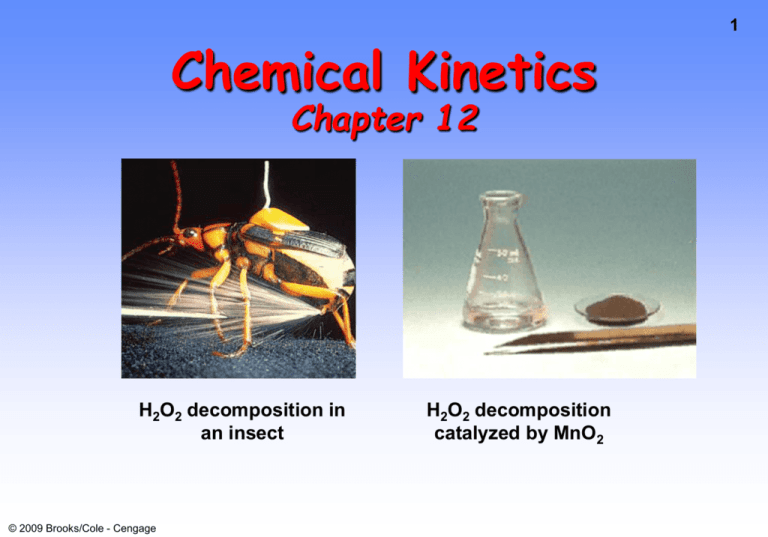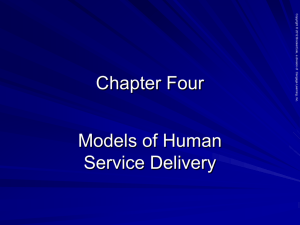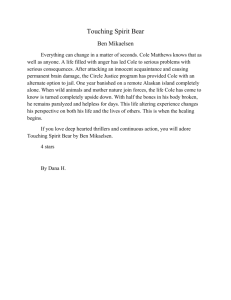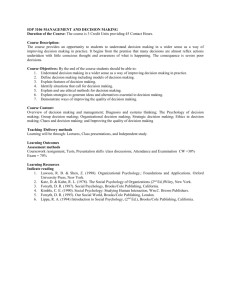Rate
advertisement

Chemical Kinetics Chapter 12 H2O2 decomposition in an insect © 2009 Brooks/Cole - Cengage H2O2 decomposition catalyzed by MnO2 1 Objectives • Understand rates of reaction and the conditions affecting rates. • Derive a rate of reaction, rate constant, and reaction order from experimental data • Use integrated rate laws • Discuss collision theory and the role of activation energy in a reaction • Discuss reaction mechanisms and their effect on rate law © 2009 Brooks/Cole - Cengage 2 Chemical Kinetics • We can use thermodynamics to tell if a reaction is product- or reactant-favored. • But this gives us no info on HOW FAST reaction goes from reactants to products. • KINETICS — the study of REACTION RATES and their relation to the way the reaction proceeds, i.e., its MECHANISM. © 2009 Brooks/Cole - Cengage 3 Reaction Mechanisms • A reaction mechanism is a sequence of events at the molecular level that control the speed and outcome of a reaction. • The reaction mechanism is our goal! © 2009 Brooks/Cole - Cengage 4 Reaction Rates Section 12.1 • Reaction rate = change in concentration of a reactant or product with time. • Three “types” of rates –initial rate –average rate –instantaneous rate © 2009 Brooks/Cole - Cengage 5 Factors Affecting Reaction Rates 6 • Physical State of the Reactants – – Gas, liquid or solid – how molecules are able to interact with each other Solids react faster when surface area is greater so fine powders react faster than big chunks • Concentration of Reactants – As the concentration of reactants increases, so does the likelihood that reactant molecules will collide. • Temperature – At higher temperatures, reactant molecules have more kinetic energy, move faster, and collide more often and with greater energy. • Catalysts – – Speed up reaction by changing mechanism. Catalysts don’t get used up themselves © 2009 Brooks/Cole - Cengage 7 Concentrations & Rates Mg(s) + 2 HCl(aq) MgCl2(aq) + H2(g) 0.3 M HCl © 2009 Brooks/Cole - Cengage 6 M HCl Factors Affecting Rates • Physical state of reactants © 2009 Brooks/Cole - Cengage 8 Factors Affecting Rates Catalysts: catalyzed decomp of H2O2 2 H2O2 2 H2O + O2 © 2009 Brooks/Cole - Cengage 9 Factors Affecting Rates • Temperature Bleach at 54 ˚C © 2009 Brooks/Cole - Cengage Bleach at 22 ˚C 10 Determining a Reaction Rate Dye Conc Blue dye is oxidized with bleach. Its concentration decreases with time. The rate — the change in dye conc with time — can be determined from the plot. Time © 2009 Brooks/Cole - Cengage 11 Determining a Reaction Rate © 2009 Brooks/Cole - Cengage 12 Reaction Rates C4H9Cl(aq) + H2O(l) C4H9OH(aq) + HCl(aq) Average Rate, M/s © 2009 Brooks/Cole - Cengage The average rate of the reaction over each interval is the change in concentration divided by the change in time: 13 Reaction Rates C4H9Cl(aq) + H2O(l) C4H9OH(aq) + HCl(aq) • Note that the average rate decreases as the reaction proceeds. • This is because as the reaction goes forward, there are fewer collisions between reactant molecules. © 2009 Brooks/Cole - Cengage 14 Reaction Rates C4H9Cl(aq) + H2O(l) C4H9OH(aq) + HCl(aq) • A plot of concentration vs. time for this reaction yields a curve like this. • The slope of a line tangent to the curve at any point is the instantaneous rate at that time. Δ[𝑨] 𝑪𝒉𝒂𝒏𝒈𝒆 𝒊𝒏 𝒎𝒐𝒍𝒂𝒓𝒊𝒕𝒚 = Δ𝒕 𝒄𝒉𝒂𝒏𝒈𝒆 𝒊𝒏 𝒕𝒊𝒎𝒆 © 2009 Brooks/Cole - Cengage 15 Reaction Rates C4H9Cl(aq) + H2O(l) C4H9OH(aq) + HCl(aq) • The reaction slows down with time because the concentration of the reactants decreases. [A] Change in molarity t Change in time © 2009 Brooks/Cole - Cengage 16 Reaction Rates and Stoichiometry C4H9Cl(aq) + H2O(l) C4H9OH(aq) + HCl(aq) • In this reaction, the ratio of C4H9Cl to C4H9OH is 1:1. • Thus, the rate of disappearance of C4H9Cl is the same as the rate of appearance of C4H9OH. Rxn -[C4H9Cl] = Rate = t © 2009 Brooks/Cole - Cengage [C4H9OH] t 17 Reaction Rates 18 2NO2(g) 2NO(g) + O2(g) [C4H9Cl] M © 2009 Brooks/Cole - Cengage In this reaction, the concentration of nitrogen dioxide, NO2, was measured at various times, t. Reaction Rates and Stoichiometry • What if the ratio is not 1:1? 2NO2(g) 2NO(g) + O2(g) • 2NO can be made from 2NO2 consumed, but only 1 O2 is produced. ∆ 𝑵𝑶𝟐 − ∆𝒕 = ∆ 𝑵𝑶 ∆𝒕 =𝟐 ∆ 𝑶𝟐 ∆𝒕 Read as: the rate of consumption of NO2 is the same as the rate of production of NO. This is because their coefficients are the same. © 2009 Brooks/Cole - Cengage 19 20 Reaction Rates But since the coefficient for oxygen is ½ of the other two, it’s rate is of production rate is half as fast. Or 2 x rate O2 = rate of NO © 2009 Brooks/Cole - Cengage 21 Reaction Rates Reaction Rate and Stoichiometry summary: • For the reaction C4H9Cl(aq) + H2O(l) C4H9OH(aq) + HCl(aq) we know 𝐑𝐚𝐭𝐞 = Δ[𝑪𝟒𝑯𝟗𝑪𝒍] − Δ𝒕 = Δ[𝑪𝟒𝑯𝟗𝑶𝑯] Δ𝒕 • In general for aA + bB cC + dD Rxn 𝐑𝐚𝐭𝐞 = © 2009 Brooks/Cole - Cengage 𝟏Δ 𝑨 − 𝒂 Δ𝒕 = 𝟏Δ 𝑩 − 𝒃 Δ𝒕 = 𝟏Δ 𝑪 𝒄 Δ𝒕 = 𝟏 Δ[𝑫] 𝒅 Δ𝒕 Reaction Rates Practice 1. What is the relative rate of disappearance of the reactants and relative rate of appearance of the products for each reaction? A. 2O3(g) 3O2(g) B. 2HOF(g) 2HF(g) + O2(g) 2. In the synthesis of ammonia, if Δ[H2]/Δt =-4.5 x 10-4 mol/L•min, what is rate with respect to NH3? wrt N2? N2(g) + 3H2(g) 2NH3(g) © 2009 Brooks/Cole - Cengage 22 Concentrations & Rates 2NO2(g) 2NO(g) + O2(g) Rate of reaction is proportional to [NO2] We express this as a RATE LAW Rate of reaction = k [NO2]n where k = rate constant k is independent of conc. but increases with T n is the order of the reactant © 2009 Brooks/Cole - Cengage 23 Concentrations, Rates, & Rate Laws In general, for a A + b B x X with a catalyst C Rate = k [A]m[B]n[C]p The exponents m, n, and p: • sum of m, n and p are the reaction order • can be 0, 1, 2 or fractions like 3/2 • must be determined by experiment! They are not simply related to stoichiometry! © 2009 Brooks/Cole - Cengage 24 Ch. 12.3 - Interpreting Rate Laws Determining Rate by inspection (quick method): Rate = k [A]m[B]n[C]p • If m = 1, rxn. is 1st order in A Rate = k [A]1 If [A] doubles, then rate goes up by factor of _2_ • If m = 2, rxn. is 2nd order in A. Rate = k [A]2 Doubling [A] increases rate by ___4_____ • If m = 0, rxn. is zero order. Rate = k [A]0 If [A] doubles, rate _Stays the same_ © 2009 Brooks/Cole - Cengage 25 The method of Initial Rates • This method requires that a reaction be run several times. • The initial concentrations of the reactants are varied. • The reaction rate is measured just after the reactants are mixed. • Eliminates the effect of the reverse reaction. © 2009 Brooks/Cole - Cengage 26 Deriving Rate Laws Derive rate law and k for CH3CHO(g) CH4(g) + CO(g) from experimental data for rate of disappearance of CH3CHO Expt. [CH3CHO] (mol/L) 1 0.10 0.020 2 0.20 0.081 3 0.30 0.182 4 0.40 0.318 © 2009 Brooks/Cole - Cengage Disappear of CH3CHO (mol/L•sec) 27 Deriving Rate Laws Determination of Rate by inspection: Here the rate goes up by __4___ when initial conc. doubles. Therefore, we say this reaction is ________2nd_________ order. So, the Rate of rxn = k [CH3CHO]2 Now determine the value of k. Use expt. #3 data— 0.182 mol/L•s = k (0.30 mol/L)2 k = 2.0 (L / mol•s) Using k you can calc. rate at other values of [CH3CHO] at same T. © 2009 Brooks/Cole - Cengage 28 Deriving Rate Laws Determination of Rate by rigorous math: Rate = k[A]n 𝑹𝒂𝒕𝒆 𝒐𝒇 𝑹𝒆𝒂𝒄𝒕𝒊𝒐𝒏 𝟐 𝟎. 𝟎𝟖𝟏 𝒌 𝟎. 𝟐𝟎 𝒏 = = 𝑹𝒂𝒕𝒆 𝒐𝒇 𝑹𝒆𝒂𝒄𝒕𝒊𝒐𝒏 𝟏 𝟎. 𝟎𝟐𝟎 𝒌 𝟎. 𝟏𝟎 𝒏 Note: For easier math, put the faster rate in the numerator. 𝒏 [𝟎. 𝟐𝟎] 𝟎. 𝟐𝟎 𝟒= = 𝒏 𝟎. 𝟏𝟎 𝟎. 𝟏𝟎 4=2n n=2 © 2009 Brooks/Cole - Cengage 𝒏 29 Determination of Rate Law Practice 30 For the reaction + BrO3 + 5Br + 6H 3Br2 + 3H2O • The general form of the Rate Law is Rate = k[BrO3-]n[Br-]m[H+]p • We use experimental data to determine the values of n, m, and p • We will choose trials that vary only one of the concentrations to determine the order based upon that reactant. © 2009 Brooks/Cole - Cengage Determination of Rate Law Practice Initial concentrations (M) BrO30.10 0.20 0.20 0.10 Br0.10 0.10 0.20 0.10 H+ 0.10 0.10 0.10 0.20 Rate (M/s) 0.8 x 10-3 1.6 x 10-3 3.2 x 10-3 3.2 x 10-3 1) Determine the rate law wrt each reactant 2) Determine the rate constant, k (with units) 3) Determine the overall order of reaction © 2009 Brooks/Cole - Cengage 31 Ch. 12.4 – Integrated Rate Law (Conc vs time) What is concentration of reactant as function of time? Consider FIRST ORDER REACTIONS The rate law is 𝚫𝑨 𝐑𝐚𝐭𝐞 = − = 𝒌[𝑨] Δ𝒕𝒊𝒎𝒆 And the units of k are sec-1. © 2009 Brooks/Cole - Cengage 32 33 Integrated Rate Law • Expresses the reaction concentration as a function of time. • Form of the equation depends on the order of the rate law (differential). Rate = [A]n t • We will only work with n=0, 1, and 2 • Changes © 2009 Brooks/Cole - Cengage Concentration/Time Relations Integrating - (∆ [A] / ∆ time) = k [A], we get ln is natural logarithm [A] ln = - kt [A]0 [A]0 at time = 0 [A] / [A]0 =fraction remaining after time t has elapsed. Called the integrated first-order rate law. © 2009 Brooks/Cole - Cengage 34 Concentration/Time Relations 35 Sucrose decomposes to simpler sugars Rate of disappearance of sucrose = k [sucrose] If k = 0.21 hr-1 and [sucrose] = 0.010 M How long to drop 90% (to 0.0010 M)? Glucose © 2009 Brooks/Cole - Cengage Concentration/Time Relations Rate of disappear of sucrose = k [sucrose], k = 0.21 hr-1. If initial [sucrose] = 0.010 M, how long to drop 90% or to 0.0010 M? Use the first order integrated rate law 0.0010 -1 ln = (0.21 h )t 0.010 ln (0.100) = - 2.3 = - (0.21 hr-1)(time) time = 11 hours © 2009 Brooks/Cole - Cengage 36 Using the Integrated Rate Law The integrated rate law suggests a way to tell the order based on experiment. 2 N2O5(g) 4 NO2(g) + O2(g) Time (min) 0 1.0 2.0 5.0 [N2O5] (M) 1.00 0.705 0.497 0.173 Rate = k [N2O5] © 2009 Brooks/Cole - Cengage ln [N2O5] 0 -0.35 -0.70 -1.75 37 Using the Integrated Rate Law 2 N2O5(g) 4 NO2(g) + O2(g) Rate = k [N2O5] Data of conc. vs. time plot do not fit straight line. © 2009 Brooks/Cole - Cengage Plot of ln [N2O5] vs. time is a straight line! 38 Using the Integrated Rate Law Plot of ln [N2O5] vs. time is a straight line! Eqn. for straight line: y = mx + b ln[N2O5 ] = -kt + conc at time t rate const =-slope ln[N2O5]0 conc at time=0 All 1st order reactions have straight line plot for ln [A] vs. time. © 2009 Brooks/Cole - Cengage 39 40 Half-Life HALF-LIFE is the time it takes for 1/2 a sample is disappear. For 1st order reactions, the concept of HALF-LIFE is especially useful. See Active Figure 15.9 © 2009 Brooks/Cole - Cengage 41 Half-Life • Reaction is 1st order decomposition of H2O2. © 2009 Brooks/Cole - Cengage 42 Half-Life • Reaction after 1 half-life. • 1/2 of the reactant has been consumed and 1/2 remains. © 2009 Brooks/Cole - Cengage 43 Half-Life • After 2 half-lives 1/4 of the reactant remains. © 2009 Brooks/Cole - Cengage 44 Half-Life • A 3 half-lives 1/8 of the reactant remains. © 2009 Brooks/Cole - Cengage 45 Half-Life • After 4 half-lives 1/16 of the reactant remains. © 2009 Brooks/Cole - Cengage Half-Life Sugar is fermented in a 1st order process (using an enzyme as a catalyst). sugar + enzyme products Rate of disappear of sugar = k[sugar] k = 3.3 x 10-4 sec-1 What is the half-life of this reaction? © 2009 Brooks/Cole - Cengage 46 Half-Life 47 Rate = k[sugar] and k = 3.3 x 10-4 sec-1. What is the halflife of this reaction? Solution [A] / [A]0 = fraction remaining when t = t1/2 then fraction remaining = _______ Therefore, ln (1/2) = - k · t1/2 NOTE: For a first-order - 0.693 = - k · t1/2 process, the half-life t1/2 = 0.693 / k does not depend on [A]0. So, for sugar, t1/2 = 0.693 / k = 2100 sec = 35 © 2009 Brooks/Cole - Cengage min Half-Life Rate = k[sugar] and k = 3.3 x 10-4 sec-1. Half-life is 35 min. Start with 5.00 g sugar. How much is left after 2 hr and 20 min (140 min)? Solution 2 hr and 20 min = 4 half-lives Half-life Time Elapsed Mass Left 1st 35 min 2.50 g 2nd 70 1.25 g 3rd 105 0.625 g 4th 140 0.313 g © 2009 Brooks/Cole - Cengage 48 49 Second Order • • • • • • • Rate = -Δ[A]/Δt = k[A]2 integrated rate law 1/[A] = kt + 1/[A]0 y= 1/[A] m=k x= t b = 1/[A]0 A straight line if 1/[A] vs t is plotted Knowing k and [A]0 you can calculate [A] at any time t © 2009 Brooks/Cole - Cengage Determining rxn order The decomposition of NO2 at 300°C is described by the equation NO2 (g) NO (g) + 1/2 O2 (g) and yields these data: Time (s) 0.0 50.0 100.0 200.0 300.0 © 2009 Brooks/Cole - Cengage [NO2], M 0.01000 0.00787 0.00649 0.00481 0.00380 50 Determining rxn order Graphing ln [NO2] vs. t yields: • The plot is not a straight line, so the process is not first-order in [A]. Time (s) 0.0 50.0 100.0 200.0 300.0 [NO2], M 0.01000 0.00787 0.00649 0.00481 0.00380 © 2009 Brooks/Cole - Cengage ln [NO2] -4.610 -4.845 -5.038 -5.337 -5.573 Does not fit: 51 Second-Order Processes A graph of 1/[NO2] vs. t gives this plot. Time (s) 0.0 50.0 100.0 200.0 300.0 © 2009 Brooks/Cole - Cengage [NO2], M 0.01000 0.00787 0.00649 0.00481 0.00380 1/[NO2] 100 127 154 208 263 • This is a straight line. Therefore, the process is second-order in [NO2]. 52 53 Zero Order Rate Law • Rate = k[A]0 = k • Rate does not change with concentration. • Integrated [A] = -kt + [A]0 • When [A] = [A]0/2 then t = t1/2 • t1/2 = [A]0 /2k © 2009 Brooks/Cole - Cengage 54 Zero Order Rate Law • Most often when reaction happens on a surface because the surface area stays constant. • Also applies to enzyme chemistry. © 2009 Brooks/Cole - Cengage 55 C o n c e n t r a t i o n k = [A]/t [A] © 2009 Brooks/Cole - Cengage t Time Rate Laws Summary Rate Law Integrated Rate Law Plot that produces a straight line Relationship of rate constant to slope of straight line Half-Life © 2009 Brooks/Cole - Cengage 56 Zero Order First Order Second Order Rate = k [A] = -kt + [A]0 Rate = k[A] ln[A] = -kt + ln[A]0 Rate = k[A]2 [A] versus t ln[A] versus t 1 versus t [ A] Slope = -k Slope = -k Slope = k [ A]0 t1/ 2 2k 0.693 t1/ 2 k 1 1 kt [ A] [ A]0 1 t1/ 2 k [ A]0 Ch. 12.5 - Reaction Mechanisms Mechanism: how reactants are converted to products at the molecular level. RATE LAW MECHANISM experiment theory © 2009 Brooks/Cole - Cengage 57 Reaction Mechanisms • The molecularity of a process tells how many molecules are involved in the process. • The rate law for an elementary step is written directly from that step. © 2009 Brooks/Cole - Cengage 58 Reaction Mechanisms • If a reaction is an elementary step, then we know its rate law. • All of the molecules involved in an elementary step are defined in the rate law. • The full molecularity has to be included. • The sum of the elementary steps in a mechanism must give the overall balanced equation for the reaction. © 2009 Brooks/Cole - Cengage 59 Molecularity Example • Given the reactions and their rate laws below, which is the only one that can be an elementary step? A) 2A P Rate = k[A] B) A + B P Rate = k[A][B] C) A + 2B P Rate = k[A]2 D) A + B + C P Rate = k[A][C] © 2009 Brooks/Cole - Cengage 60 Mechanisms Most rxns. involve a sequence of elementary steps. 2 I- + H2O2 + 2 H+ I2 + 2 H2O Rate = k [I-] [H2O2] NOTE 1. Rate law comes from experiment 2. Order and stoichiometric coefficients not necessarily the same! 3. Rate law reflects all chemistry down to and including the slowest step in multistep reaction. © 2009 Brooks/Cole - Cengage 61 Mechanisms Most rxns. involve a sequence of elementary steps. 2 I- + H 2 O 2 + 2 H + I 2 + 2 H 2 O Rate = k [I-] [H2O2] Proposed Mechanism Step 1 — slow HOOH + I- HOI + OH- Step 2 — fast HOI + I- I2 + OH- Step 3 — fast 2 OH- + 2 H+ 2 H2O Rate of the reaction controlled by slow step — RATE DETERMINING STEP, rds. Rate can be no faster than rds! © 2009 Brooks/Cole - Cengage 62 Mechanisms 2 I- + H2O2 + 2 H+ I2 + 2 H2O Rate = k [I-] [H2O2] Step 1 — slow HOOH + I- HOI + OHStep 2 — fast HOI + I- I2 + OHStep 3 — fast 2 OH- + 2 H+ 2 H2O Elementary Step 1 is bimolecular and involves I- and HOOH. Therefore, this predicts the rate law should be Rate [I-] [H2O2] — as observed!! The species HOI and OH- are reaction intermediates. More on intermediates coming up. © 2009 Brooks/Cole - Cengage 63 Rate Laws and Mechanisms 64 NO2 + CO reaction: Rate = k[NO2]2 Two possible mechanisms Two steps: step 1 Single step Two steps: step 2 © 2009 Brooks/Cole - Cengage 65 Slow Initial Step NO2 (g) + CO (g) NO (g) + CO2 (g) • The rate law for this reaction is found experimentally to be Rate = k [NO2]2 • CO is necessary for this reaction to occur, but the rate of the reaction does not depend on its concentration. • This suggests the reaction occurs in two steps. © 2009 Brooks/Cole - Cengage Slow Initial Step 66 • A proposed mechanism for this reaction is Step 1: NO2 + NO2 NO3 + NO (slow) Step 2: NO3 + CO NO2 + CO2 (fast) • The NO3 intermediate is consumed in the second step. • As CO is not involved in the slow, rate-determining step, it does not appear in the rate law. © 2009 Brooks/Cole - Cengage 67 Fast Initial Step • The rate law for this reaction is found (experimentally) to be • Because termolecular (aka trimolecular) processes are rare, this rate law suggests a twostep mechanism. 67 © 2009 Brooks/Cole - Cengage 68 Fast Initial Step • A proposed mechanism is Step 1 is an equilibriumit includes the forward and reverse reactions. © 2009 Brooks/Cole - Cengage Fast Initial Step • The rate of the overall reaction depends upon the rate of the slow step. • The rate law for that step would be • But how can we find [NOBr2]? © 2009 Brooks/Cole - Cengage 69 Intermediates • [NOBr2] is an intermediate, an unstable molecule of low, unknown concentration • Intermediates can’t appear in the rate law. • Remember: only reactants (and products, rarely) can appear in a rate law. • Slow step determines the rate and the rate law. © 2009 Brooks/Cole - Cengage 70 Intermediates • Use the reactions that form them • If the reactions are fast and irreversible the concentration of the intermediate is based on stoichiometry. • If it is formed by a reversible reaction set the rates equal to each other. © 2009 Brooks/Cole - Cengage 71 Fast Initial Step • NOBr2 can react two ways: – With NO to form NOBr – By decomposition to reform NO and Br2 • The reactants and products of the first step are in equilibrium with each other. • Therefore, Ratef = Rater © 2009 Brooks/Cole - Cengage 72 Fast Initial Step • Because Ratef = Rater , k1 [NO] [Br2] = k−1 [NOBr2] Solving for [NOBr2] gives us k1/k-1 [NO] [Br2] = [NOBr2] © 2009 Brooks/Cole - Cengage 73 Fast Initial Step Substituting this expression for [NOBr2] in the rate law for the rate-determining step gives 74 © 2009 Brooks/Cole - Cengage 74 Ch. 12.6 – A Model for Kinetics Molecules need a minimum amount of energy to react. Visualized as an energy barrier - activation energy, Ea. Reaction coordinate diagram © 2009 Brooks/Cole - Cengage 75 MECHANISMS & Activation Energy Conversion of cis to trans-2-butene requires twisting around the C=C bond. Rate = k [trans-2-butene] © 2009 Brooks/Cole - Cengage 76 MECHANISMS Cis Transition state 77 Trans Activation energy barrier © 2009 Brooks/Cole - Cengage MECHANISMS 78 Energy involved in conversion of trans to cis butene energy Activated Complex +262 kJ cis -266 kJ 4 kJ/mol trans © 2009 Brooks/Cole - Cengage Collision Theory Reactions require (a) activation energy and (b) correct orientation. O3(g) + NO(g) O2(g) + NO2(g) 1. Activation energy © 2009 Brooks/Cole - Cengage 2. Activation energy and geometry 79 Mechanisms O3 + NO reaction occurs in a single ELEMENTARY step. Most others involve a sequence of elementary steps. Adding elementary steps gives NET reaction. © 2009 Brooks/Cole - Cengage 80 Mechanisms • Reaction passes thru a TRANSITION STATE where there is an activated complex that has sufficient energy to become a product. ACTIVATION ENERGY, Ea = energy req’d to form activated complex. Here Ea = 262 kJ/mol © 2009 Brooks/Cole - Cengage 81 MECHANISMS Also note that trans-butene is MORE STABLE than cis-butene by about 4 kJ/mol. Therefore, cis trans is EXOTHERMIC This is the connection between thermodynamics and kinetics. © 2009 Brooks/Cole - Cengage 82 Effect of Temperature • Reactions generally occur slower at lower T. In ice at 0 oC Room temperature Iodine clock reaction. H2O2 + 2 I- + 2 H+ 2 H2O + I2 © 2009 Brooks/Cole - Cengage 83 Activation Energy and Temperature Reactions are faster at higher T because a larger fraction of reactant molecules have enough energy to convert to product molecules. In general, differences in activation energy cause reactions to vary from fast to slow. © 2009 Brooks/Cole - Cengage 84 Mechanisms 1. Why is trans-butene cis-butene reaction observed to be 1st order? As [trans] doubles, number of molecules with enough E also doubles. 2. Why is the trans cis reaction faster at higher temperature? Fraction of molecules with sufficient activation energy increases with T. © 2009 Brooks/Cole - Cengage 85 More About Activation Energy Arrhenius equation — Rate constant k Ae Frequency factor Temp (K) -E a / RT Activation 8.31 x 10-3 kJ/K•mol energy Frequency factor related to frequency of collisions with correct geometry. Ea 1 ln k = - ( )( ) + ln A R T © 2009 Brooks/Cole - Cengage 86 Plot ln k vs. 1/T straight line. slope = -Ea/R Arrhenius Equation Example • Calculate the Ea from the data below. • T(⁰C) k(s-1) • 189.7 2.52 X 10-5 • 198.9 5.25 X 10-5 • 230.3 6.30 X 10-4 • 251.2 3.16 X 10-3 © 2009 Brooks/Cole - Cengage 87 Arrhenius Equation Example • 1st step change T(⁰C) to T(K), find 1/T and change k to ln k. T(K) 1/T ln(k) 462.9 0.002160 -10.589 472.1 0.002118 -9.855 503.5 0.001986 -7.370 524.4 0.001907 -5.757 © 2009 Brooks/Cole - Cengage 88 89 Arrhenius Plot -4 0.00185 -5 0.0019 0.00195 0.002 0.00205 0.0021 0.00215 ln k -6 -7 y = -19080x + 30.582 R² = 0.9995 -8 -9 -10 -11 1/T © 2009 Brooks/Cole - Cengage 0.0022 Arrhenius Equation Example 90 2nd Step find the slope (If not using graphing calculator or excel) Slope = (-5.757 – (-9.855))/(0.001907 – 0.002118) = 4.098/(-0.000211) = -19422 K 3rd Step Multiply the slope by -8.314 J/mol K to get Ea = -19422 s-1 * -8.314 J/mol K = 161472 J = 161 kJ © 2009 Brooks/Cole - Cengage More on the Arrhenius Equation Determining the Activation Energy • If we do not have a lot of data, then we recognize Ea ln k1 ln A and RT1 Ea ln k2 ln A RT2 Ea Ea ln k1 ln k2 ln A ln A RT1 RT2 k1 Ea 1 1 ln k2 R T2 T1 © 2009 Brooks/Cole - Cengage 91 Example Problem • The Ea of a certain reaction is 65.7 kJ/mol. How many times faster is the rxn at 50⁰C than at 0⁰C? © 2009 Brooks/Cole - Cengage 92 Ch. 12.7 - CATALYSIS 93 Catalysts speed up reactions by altering the mechanism to lower the activation energy barrier. Dr. James Cusumano, Catalytica Inc. PLAY MOVIE What is a catalyst? PLAY MOVIE Catalysts and the environment PLAY MOVIE © 2009 Brooks/Cole - Cengage Catalysts and society CATALYSIS In auto exhaust systems — Pt, NiO 2 CO + O2 2 CO2 2 NO N2 + O2 © 2009 Brooks/Cole - Cengage 94 CATALYSIS 2. Polymers: H2C=CH2 polyethylene 3. Acetic acid: CH3OH + CO CH3CO2H 4. Enzymes — biological catalysts © 2009 Brooks/Cole - Cengage 95 CATALYSIS Catalysis and activation energy MnO2 catalyzes decomposition of H2O2 2 H2O2 2 H2O + O2 Uncatalyzed reaction Catalyzed reaction © 2009 Brooks/Cole - Cengage 96 Iodine-Catalyzed Isomerization of cis-2-Butene See Figure 15.15 © 2009 Brooks/Cole - Cengage 97 Iodine-Catalyzed Isomerization of cis-2-Butene © 2009 Brooks/Cole - Cengage 98 AP Exam Practice • 2010 AP Exam #3b-d • 2009B AP Exam #2 • 2009 AP exam #3d-e • 2008 AP Exam #3d-f • 2008B AP Exam #2a-g • 2005B AP Exam #3 • 2005 AP Exam #3 • 2003 AP Exam #3a-c © 2009 Brooks/Cole - Cengage 99







